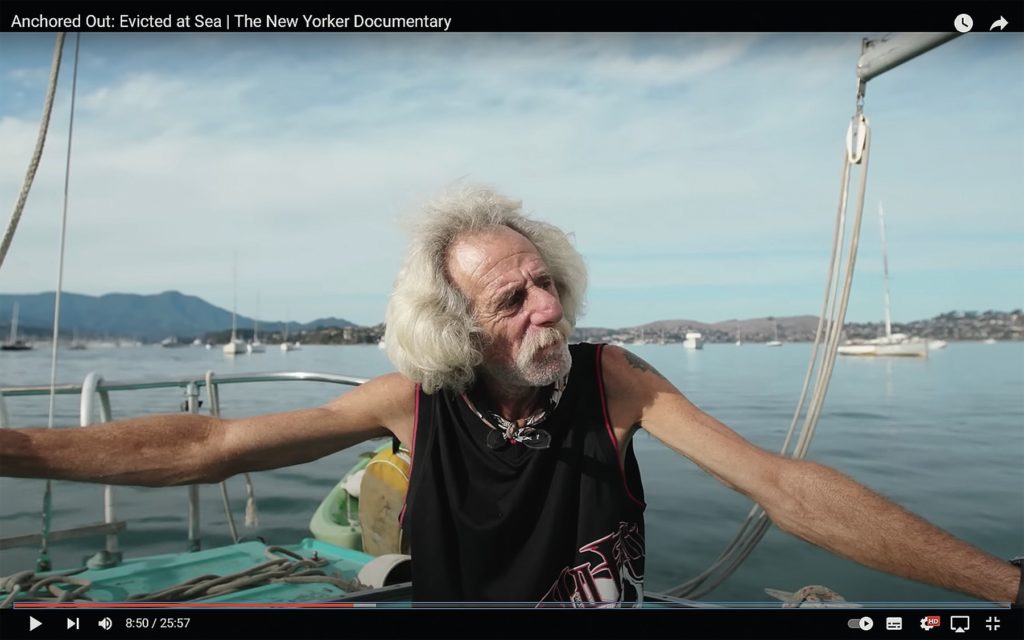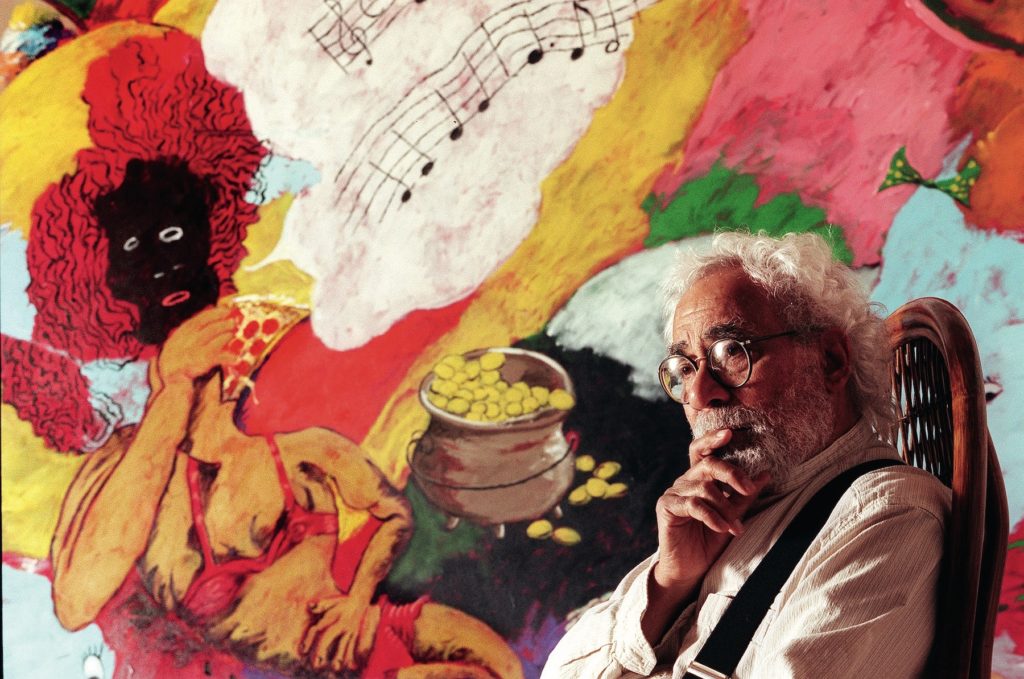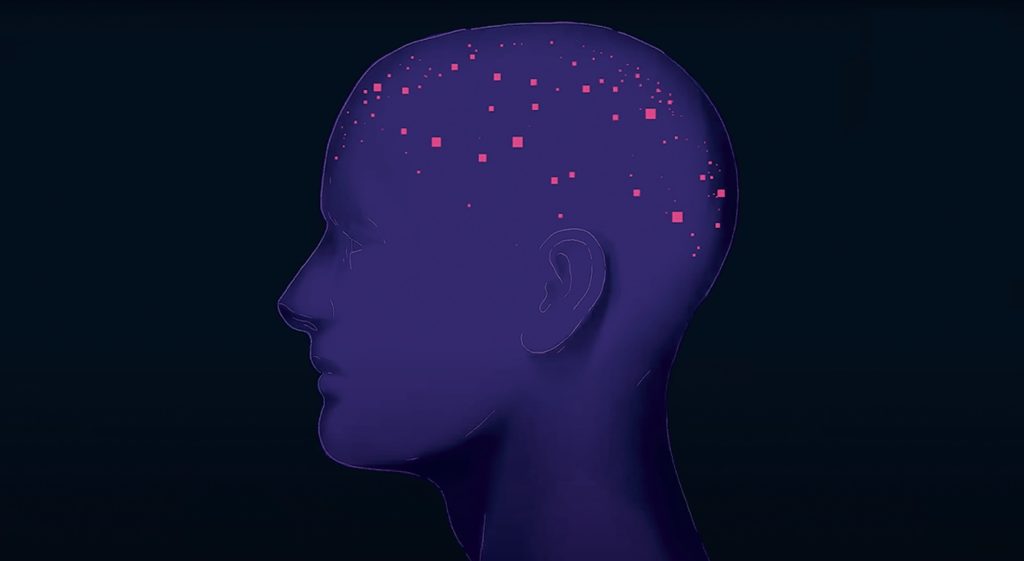
Anchored Out: Evicted at Sea
Directed by Katie Bernstein, M.J. ’21, and Clara Mokri, M.J. ’21
Joe “Einstein” Bernstein never goes grocery shopping in the daytime. If he did, there’s a chance his home would be gone when he got back.
The film Anchored Out: Evicted at Sea, part of the New Yorker Documentary series, follows the growing conflict between “anchor-outs” like Bernstein, who have spent decades living on boats in Richardson Bay, and the affluent residents of neighboring cities like Sausalito, who want the anchor-outs evicted.
The conflict intensified when the Richardson’s Bay Regional Agency began enforcing a long-standing, but often flouted, law prohibiting boats from anchoring in place longer than 72 hours. Then-harbormaster Curtis Havel, tasked with towing and even destroying boats which violate the statute, believes the law is necessary due to the abundance of inoperable vessels on the bay. “When a storm comes through, how can they stop themselves from colliding into [another] boat?” he asks in the film. “And then if they do collide into that boat, who’s going to pay for that? The taxpayer?”
But the majority of the anchor-outs are poor and elderly folks whose boats are their only home. One houseboat resident tells the filmmakers the cities will ultimately prevail. “It’s all about money, guns, and lawyers … They’re going to get rid of all of [the anchor-outs]. They’re going to put mooring balls out there. And they’re going to have millionaire boats tied up to ’em.”
—M.N.

Border Hacker: A Tale of Treachery, Trafficking, and Two Friends on the Run
By Levi Vonk, Ph.D. ’25, with Axel Kirschner
Cracked heels from traveling 300 miles on foot. An uplifted cross splattered with red paint, reading “Basta de sangre de migrantes” (“Enough of migrants’ blood”). Such is anthropologist and Ph.D. candidate Levi Vonk’s evocation of the Viacrucis Migrante—the Central American migrant caravans—that is at the heart of his recent book, Border Hacker. Vonk first traveled with the migrants in 2015, hoping to draw attention to the risks they undertake crossing borders.
On the caravan, Vonk met Axel Kirschner, an undocumented immigrant who had just been deported from New York City to Guatemala. As the title suggests, Kirschner is also a talented hacker, a skill often exploited by powerful individuals.
The two men alternate passages as they describe their attempts to free Kirschner from the grasp of corrupt Mexican politicians and so-called humanitarians, and return him home.
Though Kirschner uses a pseudonym to protect his identity, Border Hacker’s publication has, Vonk reports, elicited death threats from the people the book condemns. “They are politically powerful elites with connections to the federal police, senators, and—in one instance—even the president himself,” the author wrote on Twitter. “Someone is trying to find us and shut us up.”
Border Hacker is more than just another book about the dangers of immigration—it’s the tale of friendship forged by shared trauma. Vonk writes, “It’s about the relationship between us, and how two people who could not be more different on paper—a young, Southern, white academic and an undocumented, Afro-Latino, New York hustler—can still share something.”
—M.N.

Art and Race Matters: The Career of Robert Colescott
Vibrant colors and highly provocative racial caricatures feature heavily in the boldly satirical works of Robert Colescott ’49, M.A. ’51 (1925–2009), a neo-expressionist painter who, in 1997, became the first Black artist to represent the United States in a solo exhibition at the Venice Biennale.
Organized by the Contemporary Arts Center in Cincinnati and now being shown at the New Museum in Manhattan, the traveling exhibition Art and Race Matters presents a “long overdue” celebration of the artist’s work, featuring his reimaginings of pieces by artists ranging from Van Gogh to Emanuel Leutze. Colescott often inserted Black figures into the compositions.
These were not necessarily dignified characters. Eat Dem Taters and George Washington Carver Crossing the Delaware: Page from an American History Textbook, among others, feature minstrel characters in blackface, with enlarged lips and foolish grins. Such pieces force viewers to grapple with grotesque racial stereotypes and deep-rooted taboos in ways that are often uncomfortable. This seemed to be Colescott’s goal.
“When I get my work up in a gallery,” Colescott wrote, “you see this room full of big, sensuous paintings. It’s the first impact that people get. They walk in and say, ‘Oh wow!’ and then, ‘Oh shit!’ when they see what they have to deal with in subject matter. It’s an integrated ‘one-two punch’: it gets them every time.”
The exhibit runs through October 9.
—M.B.

How To Change Your Mind
Michael Pollan
Author and Berkeley journalism professor Michael Pollan has made a career of complicating our view of what we put in our mouths. First, The Botany of Desire and The Omnivore’s Dilemma examined our relationship with food. More recently, his work has taken a, shall we say, Haight-Ashbury-ish turn by focusing on psychedelics. Pollan is one of the executive producers (and the star) of this new four-part Netflix docuseries based on his book of the same name exploring psychedelics’ history and therapeutic potential. The episodes focus on psilocybin (aka magic mushrooms), mescaline, MDMA, and LSD. Sound a little woo-woo? It is. But true to his science-writing roots, Pollan delves into the research and avoids the Leary-esque tropes that have dogged the study of these substances for so long. The preliminary research is promising, suggesting meaningful relief for people suffering from a range of ailments including PTSD and depression. If this all sounds too lab-coaty for you, never fear: The series also explores the spiritual aspects that have been central to Indigenous cultures’ use of psychedelic plants for centuries. And, of course, Pollan had to try some himself. He’s probably sick of people asking if his newfound interest is fueled by a midlife crisis. (Pollan is 67.) But even if it were, isn’t that more interesting than buying a sports car?
—L.S.

Vagina Obscura: An Anatomical Voyage
By Rachel E. Gross ’11
Be warned, you are entering uncharted terrain: the vagina. As science writer (and former California intern, no less) Rachel E. Gross argues in her book Vagina Obscura, the vagina has been “demonized, dismissed and left to the trash heap of history.” Gross experienced firsthand how little she and the medical community understood about this maligned organ after a misdiagnosed bacterial infection. The resulting book is a tour of medical neglect and misunderstanding: from doctors in 19th century Europe, who believed that higher education would siphon blood away from the uterus, to the 1980s, when endometriosis was referred to as “the career woman’s disease.” It was only in 1993, after all, that the federal government began requiring inclusion of women and minorities in clinical trials.
The book’s not all horrors and scientific neglect. In eight chapters, Gross covers everything from myths about the “G-spot” to a gynecologist’s dedicated work at gender affirming therapy. She leaves room for wonder at the vagina’s surprising capacities. If the ability to transform, nurture, and bear a human life isn’t enough wow effect for you, take, for example, the long-held belief that ovaries contain all the eggs they ever will at birth. It was recently discovered that the vagina has more regenerative capabilities than ever thought. Then, there’s the matter of the clitoris, the only human organ whose primary purpose is pleasure, with nerves that wrap around the vagina extending to the pelvis. Feeling vagina envy, anyone?
—L.S.
Correction: It is the clitoris that has been “demonized, dismissed…”
…
California magazine is an editorially independent non-profit magazine. We need your support to keep producing award-winning journalism about the world of Berkeley and Berkeley in the world. Please consider a donation in any amount. Fiat Lux and Go Bears!




















